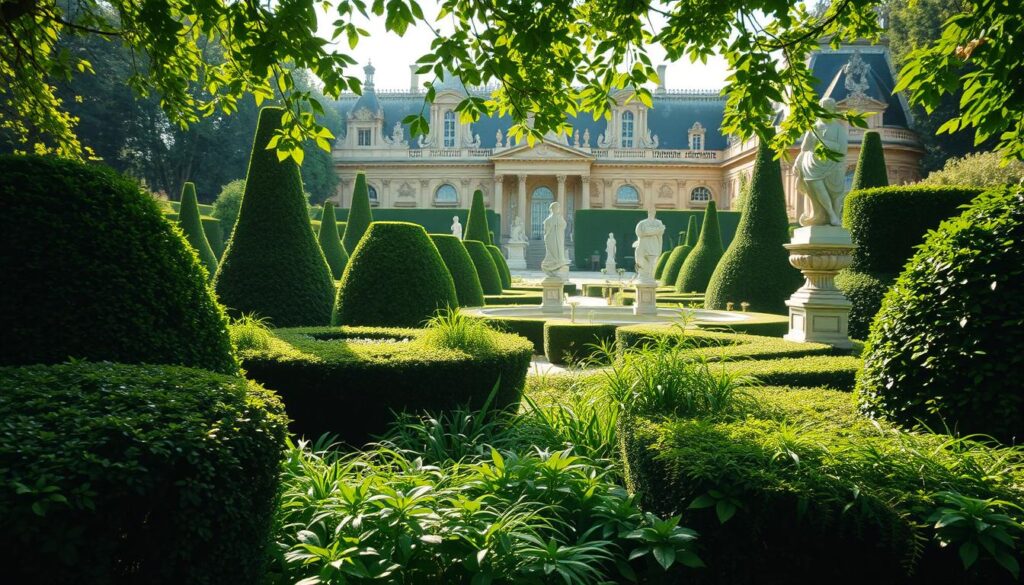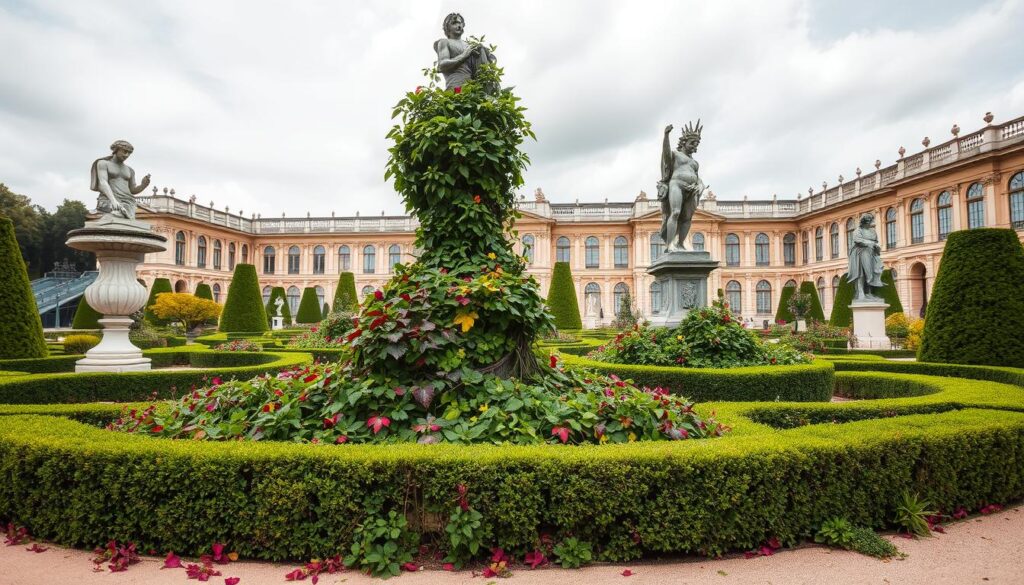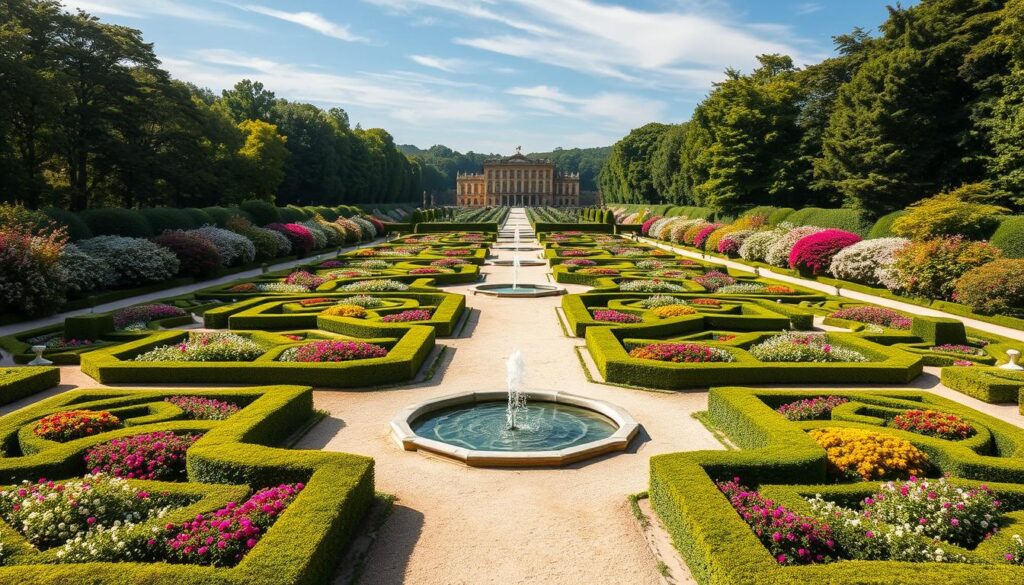Welcome to the world of weeds in Versailles, the famous French palace and gardens. As you explore this historic place, you’ll find a hidden problem. Invasive plants are a threat to Versailles’ beauty.
In this guide, we’ll talk about the fight against non-native plants. We’ll see how people work to keep Versailles’ plants safe. We’ll also learn about green ways to control weeds and keep Versailles beautiful.
Key Takeaways
- Explore the hidden world of weeds and invasive plants in the iconic Versailles gardens.
- Discover the history of non-native species and their impact on the botanical diversity of Versailles.
- Learn about the ongoing efforts to conserve the gardens and maintain their French heritage.
- Understand sustainable weed control methods and gardening practices that can help preserve Versailles.
- Appreciate the importance of proper garden maintenance in safeguarding the grandeur of this remarkable site.
Introduction: Exploring the Grandeur of Versailles Gardens
Nestled just outside Paris, the Versailles gardens show the French monarchy’s opulence. Louis XIV’s vision brings visitors into a world of beauty and history.
The Palace of Versailles: A Glimpse into Royal Extravagance
The Palace of Versailles is at the heart of the estate. It has over 700 rooms, gardens, fountains, and parks. The Hall of Mirrors is a highlight, with 357 mirrors from 1678.
This space was where the Treaty of Versailles was signed in 1919. It ended World War I.
The Queen’s Hamlet: Marie Antoinette’s Pastoral Retreat
The Queen’s Hamlet gives a peek into royal life. It was a village for Queen Marie Antoinette’s fun. She could escape court life here.
The Gallery of Coaches: A Journey Through Royal Transportation
The Gallery of Coaches is a must-see. It shows the royal cars of the French monarchy. It connects us to the past’s grandeur.
Visiting Versailles takes you back in time. You’ll see the palace, gardens, and landmarks. It’s a journey to the French royal era.
Weed in Versailles: The Hidden Menace
Beneath Versailles’ gardens lies a hidden threat: weeds and invasive plants. These plants disrupt the garden’s balance and can harm its history. It’s important to understand how to manage weeds here to keep the gardens beautiful.
The weed in Versailles shows the fight against invasive plants. These plants were brought in by humans or nature. They now compete with native plants, changing the garden’s look and harming its balance.
| Weed Species | Impact on Versailles Gardens | Control Methods |
|---|---|---|
| Japanese Knotweed | Aggressive growth, displacing native plants | Manual removal, herbicide application |
| Common Ragweed | Rapid spread, production of allergens | Mowing, hand-pulling, targeted herbicide use |
| Giant Hogweed | Toxic sap, threat to human health | Careful removal, protective equipment |
Dealing with weed in Versailles is hard. The team works hard to get rid of invasive plants. They also help native plants grow and stay safe.

“The battle against weeds in Versailles is an ongoing struggle to maintain the integrity of this iconic French landscape. It’s a testament to the resilience and dedication of the gardeners who work tirelessly to preserve the natural beauty of this UNESCO World Heritage site.”
Visitors from all over love Versailles Gardens. But, managing weed in Versailles is a big challenge. Gardeners use new ways to fight weeds and teach people about the gardens. They want to keep this French treasure safe for the future.
The History of Invasive Species in Versailles
The gardens of Versailles have a long history with invasive species. King Louis XIV started bringing in trees and shrubs from France in the 17th century. He brought chestnut and lime trees from up to 20 miles away.
By the 1730s, over 60 hectares were dedicated to growing many plants. They grew 30,000 trees every year.
Non-Native Plants and Their Impact on the Gardens
The introduction of non-native plants changed the Versailles garden. King Louis XV added more plants, making it famous in Europe. But, this also let invasive species in.
The woods in the Park of Versailles started to change in the 1760s. Now, plants like clover and dandelions compete for space and resources.
Botanical Conservation Efforts at Versailles
The team at Versailles is fighting to save the gardens. They remove non-native plants and replant native ones. They also work with experts to keep the gardens safe.
The Orangerie at Versailles has many tropical trees. They are cared for to keep the garden’s history alive. The team is working hard to keep the gardens beautiful for the future.

“The gardens of Versailles feature 2,300 rooms within the palace, 700 topiaries shorn into unnatural geometric shapes, and 2,000 acres of meticulously maintained grounds.”
Identifying and Controlling Weeds in Versailles
Dealing with weeds in Versailles gardens is key to keeping it beautiful. The gardening team at Versailles uses many ways to fight weeds. They work hard to keep the gardens looking great.
Common Weed Species Found in the Gardens
Many weeds like crabgrass and dandelions grow in Versailles gardens. Knowing these weeds helps the team fight them better. They use this knowledge to keep the gardens perfect.
- Crabgrass (Digitaria spp.): A prolific annual grass that thrives in bare or compacted soil, often invading lawns and garden beds.
- Quackgrass (Elymus repens): A perennial grass with extensive rhizome systems, making it a persistent and difficult-to-eradicate weed.
- Dandelion (Taraxacum officinale): A common broadleaf weed with a deep taproot that can quickly spread across gardens and lawns.
- Plantain (Plantago spp.): Broad-leaved perennials that can tolerate a wide range of soil conditions and are often found in high-traffic areas.
Sustainable Weed Control Methods
The Versailles team uses green ways to fight weeds. They want to protect the environment and keep the gardens beautiful. Here’s how they do it:
- Manual removal: They pull weeds by hand to get rid of them for good.
- Targeted herbicide application: They use special weed killers carefully to avoid harming good plants.
- Beneficial plant integration: They plant good plants that push weeds away, making the garden healthier.
These green methods help Versailles gardens stay amazing. Visitors can enjoy the beauty of the gardens. They also see the care for the environment.
| Location | Date | Type | Occurrence |
|---|---|---|---|
| Versailles, MO | November 2, 2024 | In-person workshop | Single event |
| Camdenton, MO | November 4, 2024 | In-person workshop | Single event |
“Maintaining the historic beauty and environmental integrity of the Versailles gardens is a constant challenge, but one that our dedicated team approaches with passion and innovation.“
– Head Gardener, Versailles
Preserving a French Heritage Site
The gardens of Versailles show French elegance and grandeur. They are a cultural treasure that needs careful care. Garden maintenance, like weed control and plant care, is key to keeping Versailles beautiful.
The Importance of Garden Maintenance at Versailles
Versailles’ gardens were once wetlands, turned into a stunning work by André Le Nôtre. We celebrate his 400th birthday, showing how vital his work is. Today, gardeners keep his dream alive with green practices.
Managing weeds is a big job for Versailles gardeners. They use special methods to keep weeds out. This keeps the gardens looking great and true to history.
The gardeners also take care of trees, shrubs, and flowers. They fix and make new tree-boxes, keeping Versailles’ look alive. These actions keep Versailles beautiful and protect its history.
Keeping Versailles’ gardens safe is very important. The garden team makes sure Versailles’ beauty and history live on. They inspire people from all over with Versailles garden maintenance, French heritage site preservation, and historic garden conservation.
Sustainable Gardening Practices in Versailles
Versailles is famous for its beautiful gardens. Today, they use green gardening to protect the environment. They keep the gardens looking great while being kind to nature.
The team at Versailles works hard to stop bad plants from taking over. They remove plants that don’t belong. This helps keep the gardens full of plants that are special to the area.
The team at Versailles also uses new ways to take care of the gardens. They use natural ways to fight pests and fix damaged areas. This shows how to take care of old places in a new way.
Versailles loves the many different living things in its gardens. They help the plants and animals live well together. This makes the gardens a special place for people to visit.
“Versailles serves as a model for heritage site preservation through sustainable, forward-thinking gardening methods.”
The team at Versailles is always finding new ways to garden better. They keep the gardens beautiful and safe from bad plants. This way, Versailles will always be a place of wonder for people.
Conclusion
The gardens of Versailles show France’s rich culture to the world. They are grand and beautiful. But, fighting weeds and invasive plants is a big challenge.
By knowing about non-native plants and using green weed control, Versailles fights to keep its beauty. They want to protect this special place for future generations.
Versailles teaches us about caring for nature and gardens. The team works hard to keep the gardens looking great. Their work shows the lasting value of this French treasure.
Keeping Versailles gardens safe is key to protecting our nature. We can help by using green gardening and saving native plants. This way, we help keep Versailles beautiful for years to come.



I Was looking for weed and i came across Zeus weed recommended by a friend . Zeus is super friendly, making it easy to get cannabis products. The delivery service is reliable with professional riders ensuring timely arrivals.
The quality of their products is top-notch, and their customer service is attentive and knowledgeable, offering helpful recommendations. Highly recommended for anyone seeking convenience, quality, and professionalism.
Add his Zangi private number for confidential correspondence text.
Zangi private Number : 1047789965
Click link for zangi : https://services.zangi.com/dl/conversation/1047789965
Contact him email : weedzeus35@gmail.com
Note:
He accept only btc/usdt and do not take cash payment.
Thanks bro, we ordered from him for the first time and couldn’t have been happier. They were willing to drive all the way out to my hotel as fast as possible . They were very helpful when we had a bunch of questions on the strains. We used both the Zangi app and text them directly . Prices are extremely reasonable – cheaper than where we were ordering from for years. They also have the strongest cannabis we’ve seen being sold – which my wife needs for medical reasons.
Will definitely be ordering from Zeus weed again.
Excellent Customer Service!!
It’s so great to speak with nice humans that care about their customers. Every order I’ve made has been 100%.
I will absolutely continue to purchase from Zeus Weed.
Zeus Weed is what made my experience great! He was kind to me and patient and answered all my questions. I loved everything about the experience. Highly recommend!
email them.. weedzeus35@gmail.com
Forget Santa coming down the chimney leaving gifts it’s the Zeus Weed arriving with the fantastic products you just ordered. Zeus weed is absolutely the best man. good choice of strains, always good service. Fast delivery what more i want. So convenient! Alittle more pricey for me but the quality is high.